Leadership and Management: A Comprehensive Analysis and Discussion
VerifiedAdded on 2020/05/16
|7
|1809
|67
Essay
AI Summary
This essay delves into the intertwined concepts of leadership and management, exploring their roles and impact within modern business environments. It examines various leadership styles and their application in different organizational contexts, emphasizing the leader's crucial role in implementing change and fostering stability. The essay draws upon the works of Alvesson and Sveningsson, Nienaber, Mintzberg, Chia, Grint, and Simonet and Tett to highlight the connections and distinctions between leadership and management, including managerial duties, communication, strategy implementation, and the challenges of organizational conflict. It underscores the importance of understanding both leadership and management for effective decision-making, employee motivation, and overall organizational success, concluding that while the two concepts have different facets, they are both essential in addressing contemporary organizational issues.
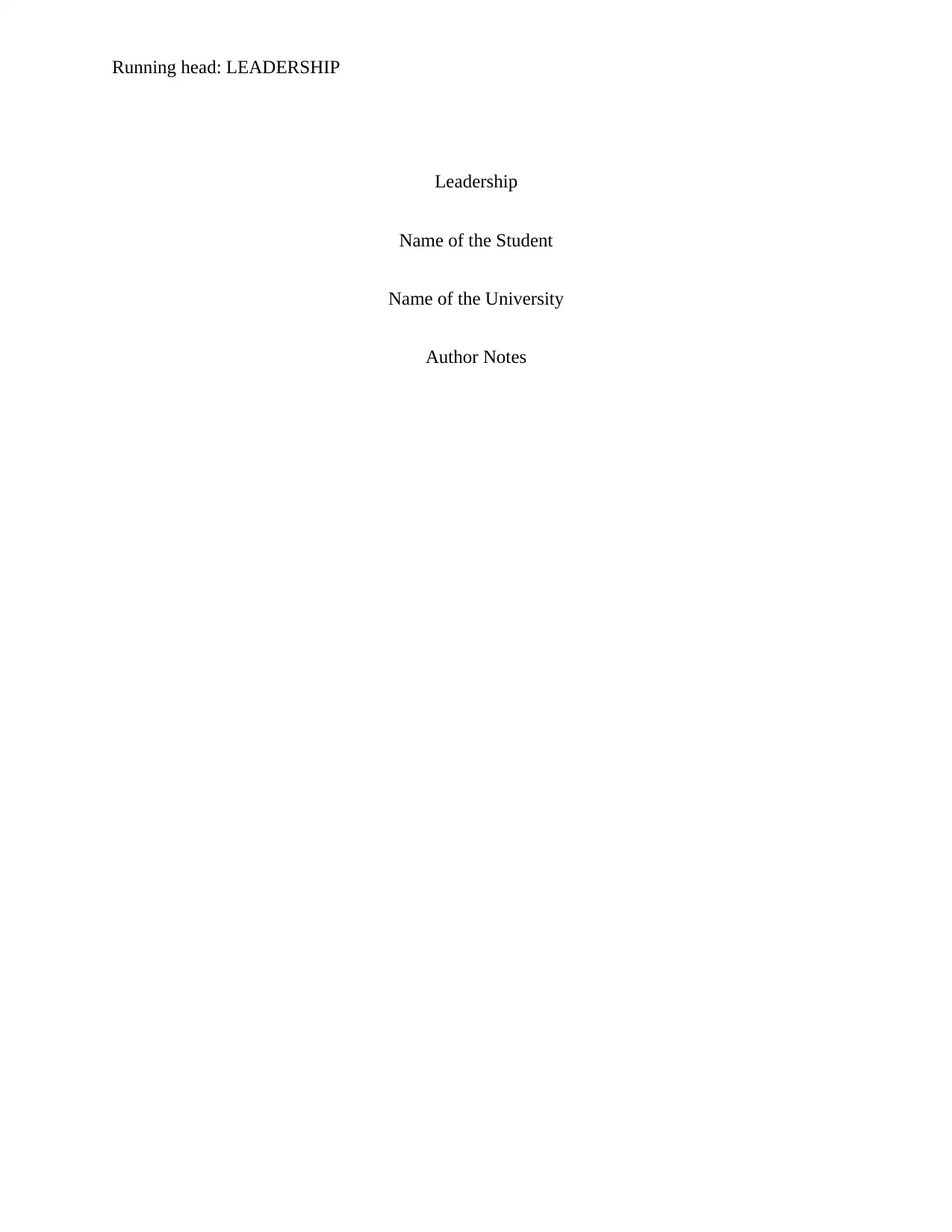
Running head: LEADERSHIP
Leadership
Name of the Student
Name of the University
Author Notes
Leadership
Name of the Student
Name of the University
Author Notes
Paraphrase This Document
Need a fresh take? Get an instant paraphrase of this document with our AI Paraphraser
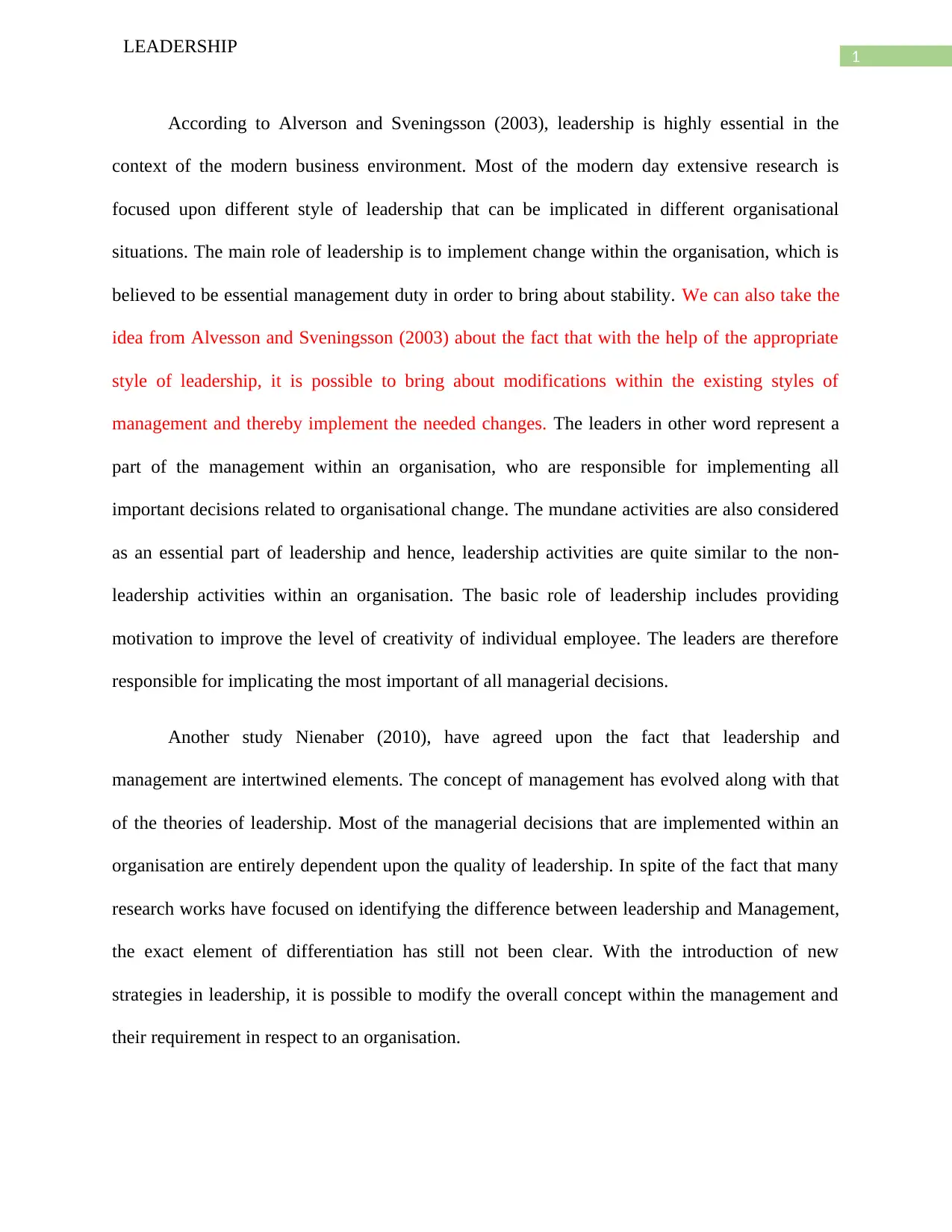
1
LEADERSHIP
According to Alverson and Sveningsson (2003), leadership is highly essential in the
context of the modern business environment. Most of the modern day extensive research is
focused upon different style of leadership that can be implicated in different organisational
situations. The main role of leadership is to implement change within the organisation, which is
believed to be essential management duty in order to bring about stability. We can also take the
idea from Alvesson and Sveningsson (2003) about the fact that with the help of the appropriate
style of leadership, it is possible to bring about modifications within the existing styles of
management and thereby implement the needed changes. The leaders in other word represent a
part of the management within an organisation, who are responsible for implementing all
important decisions related to organisational change. The mundane activities are also considered
as an essential part of leadership and hence, leadership activities are quite similar to the non-
leadership activities within an organisation. The basic role of leadership includes providing
motivation to improve the level of creativity of individual employee. The leaders are therefore
responsible for implicating the most important of all managerial decisions.
Another study Nienaber (2010), have agreed upon the fact that leadership and
management are intertwined elements. The concept of management has evolved along with that
of the theories of leadership. Most of the managerial decisions that are implemented within an
organisation are entirely dependent upon the quality of leadership. In spite of the fact that many
research works have focused on identifying the difference between leadership and Management,
the exact element of differentiation has still not been clear. With the introduction of new
strategies in leadership, it is possible to modify the overall concept within the management and
their requirement in respect to an organisation.
LEADERSHIP
According to Alverson and Sveningsson (2003), leadership is highly essential in the
context of the modern business environment. Most of the modern day extensive research is
focused upon different style of leadership that can be implicated in different organisational
situations. The main role of leadership is to implement change within the organisation, which is
believed to be essential management duty in order to bring about stability. We can also take the
idea from Alvesson and Sveningsson (2003) about the fact that with the help of the appropriate
style of leadership, it is possible to bring about modifications within the existing styles of
management and thereby implement the needed changes. The leaders in other word represent a
part of the management within an organisation, who are responsible for implementing all
important decisions related to organisational change. The mundane activities are also considered
as an essential part of leadership and hence, leadership activities are quite similar to the non-
leadership activities within an organisation. The basic role of leadership includes providing
motivation to improve the level of creativity of individual employee. The leaders are therefore
responsible for implicating the most important of all managerial decisions.
Another study Nienaber (2010), have agreed upon the fact that leadership and
management are intertwined elements. The concept of management has evolved along with that
of the theories of leadership. Most of the managerial decisions that are implemented within an
organisation are entirely dependent upon the quality of leadership. In spite of the fact that many
research works have focused on identifying the difference between leadership and Management,
the exact element of differentiation has still not been clear. With the introduction of new
strategies in leadership, it is possible to modify the overall concept within the management and
their requirement in respect to an organisation.
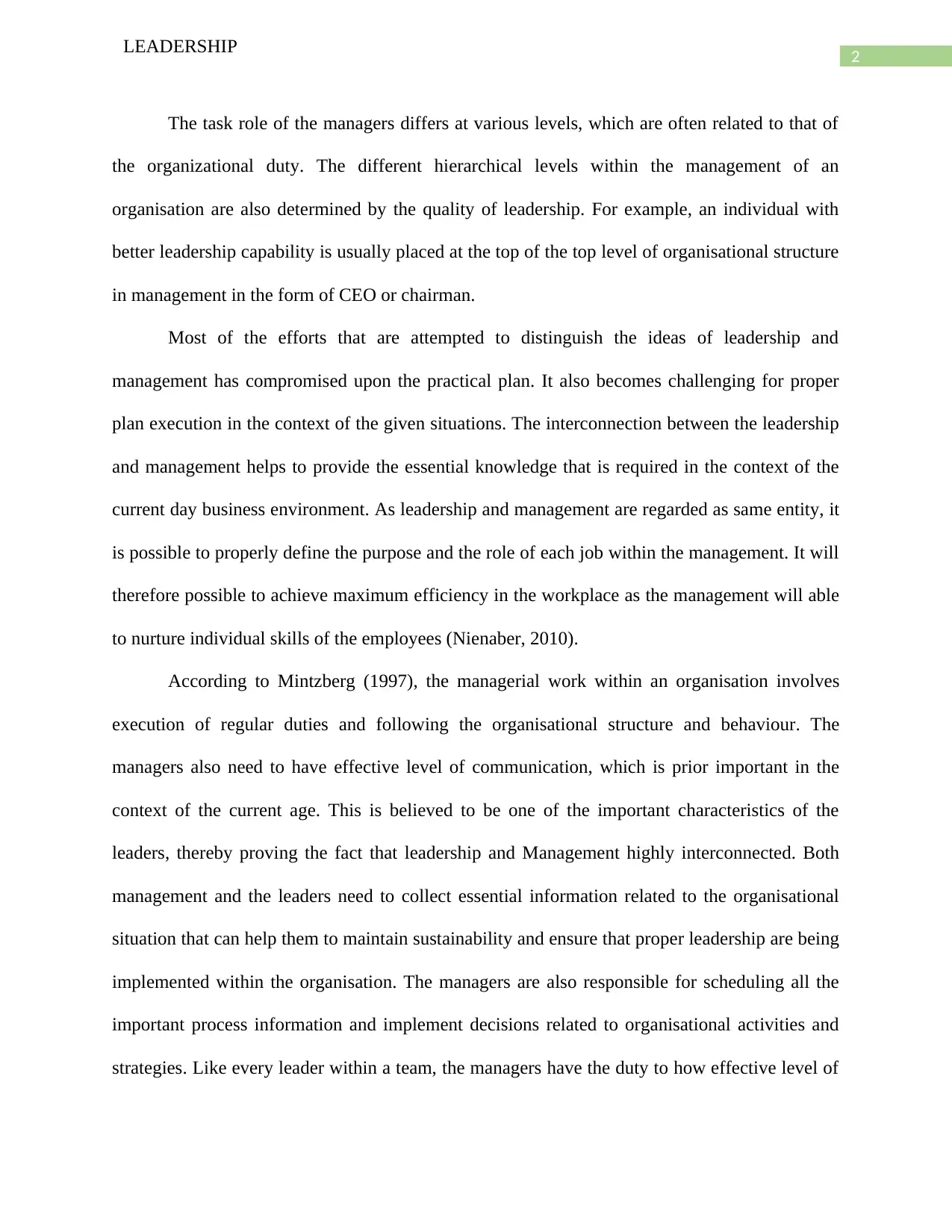
2
LEADERSHIP
The task role of the managers differs at various levels, which are often related to that of
the organizational duty. The different hierarchical levels within the management of an
organisation are also determined by the quality of leadership. For example, an individual with
better leadership capability is usually placed at the top of the top level of organisational structure
in management in the form of CEO or chairman.
Most of the efforts that are attempted to distinguish the ideas of leadership and
management has compromised upon the practical plan. It also becomes challenging for proper
plan execution in the context of the given situations. The interconnection between the leadership
and management helps to provide the essential knowledge that is required in the context of the
current day business environment. As leadership and management are regarded as same entity, it
is possible to properly define the purpose and the role of each job within the management. It will
therefore possible to achieve maximum efficiency in the workplace as the management will able
to nurture individual skills of the employees (Nienaber, 2010).
According to Mintzberg (1997), the managerial work within an organisation involves
execution of regular duties and following the organisational structure and behaviour. The
managers also need to have effective level of communication, which is prior important in the
context of the current age. This is believed to be one of the important characteristics of the
leaders, thereby proving the fact that leadership and Management highly interconnected. Both
management and the leaders need to collect essential information related to the organisational
situation that can help them to maintain sustainability and ensure that proper leadership are being
implemented within the organisation. The managers are also responsible for scheduling all the
important process information and implement decisions related to organisational activities and
strategies. Like every leader within a team, the managers have the duty to how effective level of
LEADERSHIP
The task role of the managers differs at various levels, which are often related to that of
the organizational duty. The different hierarchical levels within the management of an
organisation are also determined by the quality of leadership. For example, an individual with
better leadership capability is usually placed at the top of the top level of organisational structure
in management in the form of CEO or chairman.
Most of the efforts that are attempted to distinguish the ideas of leadership and
management has compromised upon the practical plan. It also becomes challenging for proper
plan execution in the context of the given situations. The interconnection between the leadership
and management helps to provide the essential knowledge that is required in the context of the
current day business environment. As leadership and management are regarded as same entity, it
is possible to properly define the purpose and the role of each job within the management. It will
therefore possible to achieve maximum efficiency in the workplace as the management will able
to nurture individual skills of the employees (Nienaber, 2010).
According to Mintzberg (1997), the managerial work within an organisation involves
execution of regular duties and following the organisational structure and behaviour. The
managers also need to have effective level of communication, which is prior important in the
context of the current age. This is believed to be one of the important characteristics of the
leaders, thereby proving the fact that leadership and Management highly interconnected. Both
management and the leaders need to collect essential information related to the organisational
situation that can help them to maintain sustainability and ensure that proper leadership are being
implemented within the organisation. The managers are also responsible for scheduling all the
important process information and implement decisions related to organisational activities and
strategies. Like every leader within a team, the managers have the duty to how effective level of
⊘ This is a preview!⊘
Do you want full access?
Subscribe today to unlock all pages.

Trusted by 1+ million students worldwide
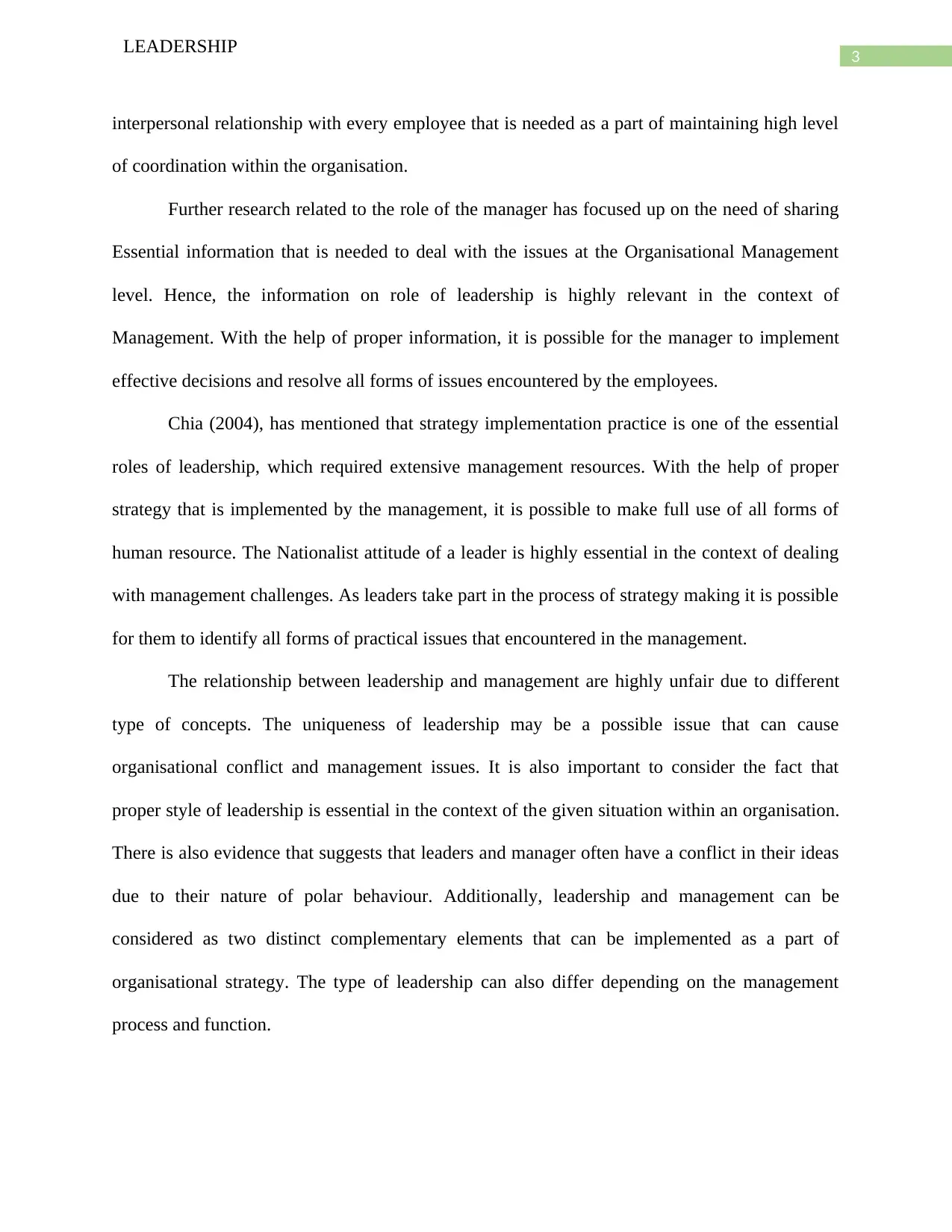
3
LEADERSHIP
interpersonal relationship with every employee that is needed as a part of maintaining high level
of coordination within the organisation.
Further research related to the role of the manager has focused up on the need of sharing
Essential information that is needed to deal with the issues at the Organisational Management
level. Hence, the information on role of leadership is highly relevant in the context of
Management. With the help of proper information, it is possible for the manager to implement
effective decisions and resolve all forms of issues encountered by the employees.
Chia (2004), has mentioned that strategy implementation practice is one of the essential
roles of leadership, which required extensive management resources. With the help of proper
strategy that is implemented by the management, it is possible to make full use of all forms of
human resource. The Nationalist attitude of a leader is highly essential in the context of dealing
with management challenges. As leaders take part in the process of strategy making it is possible
for them to identify all forms of practical issues that encountered in the management.
The relationship between leadership and management are highly unfair due to different
type of concepts. The uniqueness of leadership may be a possible issue that can cause
organisational conflict and management issues. It is also important to consider the fact that
proper style of leadership is essential in the context of the given situation within an organisation.
There is also evidence that suggests that leaders and manager often have a conflict in their ideas
due to their nature of polar behaviour. Additionally, leadership and management can be
considered as two distinct complementary elements that can be implemented as a part of
organisational strategy. The type of leadership can also differ depending on the management
process and function.
LEADERSHIP
interpersonal relationship with every employee that is needed as a part of maintaining high level
of coordination within the organisation.
Further research related to the role of the manager has focused up on the need of sharing
Essential information that is needed to deal with the issues at the Organisational Management
level. Hence, the information on role of leadership is highly relevant in the context of
Management. With the help of proper information, it is possible for the manager to implement
effective decisions and resolve all forms of issues encountered by the employees.
Chia (2004), has mentioned that strategy implementation practice is one of the essential
roles of leadership, which required extensive management resources. With the help of proper
strategy that is implemented by the management, it is possible to make full use of all forms of
human resource. The Nationalist attitude of a leader is highly essential in the context of dealing
with management challenges. As leaders take part in the process of strategy making it is possible
for them to identify all forms of practical issues that encountered in the management.
The relationship between leadership and management are highly unfair due to different
type of concepts. The uniqueness of leadership may be a possible issue that can cause
organisational conflict and management issues. It is also important to consider the fact that
proper style of leadership is essential in the context of the given situation within an organisation.
There is also evidence that suggests that leaders and manager often have a conflict in their ideas
due to their nature of polar behaviour. Additionally, leadership and management can be
considered as two distinct complementary elements that can be implemented as a part of
organisational strategy. The type of leadership can also differ depending on the management
process and function.
Paraphrase This Document
Need a fresh take? Get an instant paraphrase of this document with our AI Paraphraser
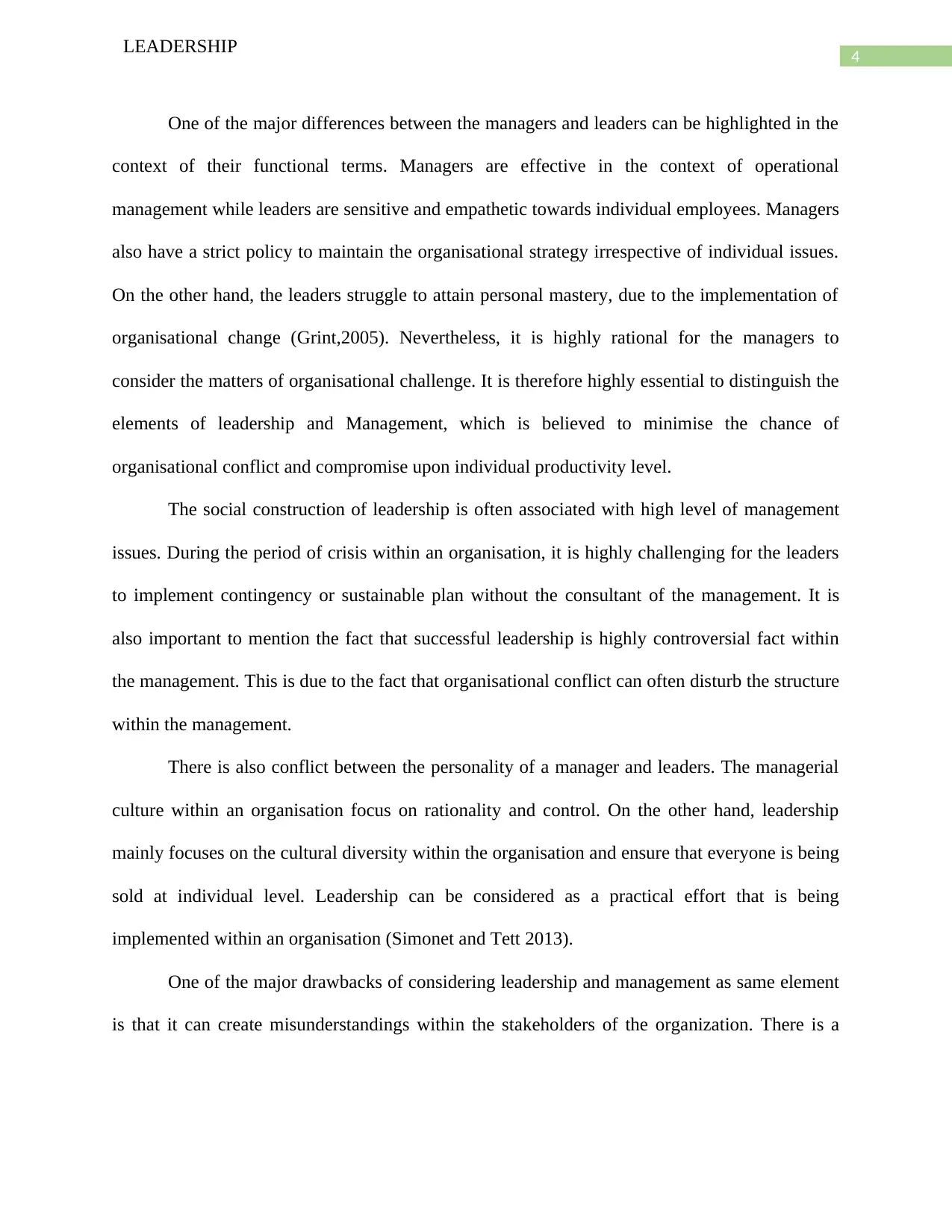
4
LEADERSHIP
One of the major differences between the managers and leaders can be highlighted in the
context of their functional terms. Managers are effective in the context of operational
management while leaders are sensitive and empathetic towards individual employees. Managers
also have a strict policy to maintain the organisational strategy irrespective of individual issues.
On the other hand, the leaders struggle to attain personal mastery, due to the implementation of
organisational change (Grint,2005). Nevertheless, it is highly rational for the managers to
consider the matters of organisational challenge. It is therefore highly essential to distinguish the
elements of leadership and Management, which is believed to minimise the chance of
organisational conflict and compromise upon individual productivity level.
The social construction of leadership is often associated with high level of management
issues. During the period of crisis within an organisation, it is highly challenging for the leaders
to implement contingency or sustainable plan without the consultant of the management. It is
also important to mention the fact that successful leadership is highly controversial fact within
the management. This is due to the fact that organisational conflict can often disturb the structure
within the management.
There is also conflict between the personality of a manager and leaders. The managerial
culture within an organisation focus on rationality and control. On the other hand, leadership
mainly focuses on the cultural diversity within the organisation and ensure that everyone is being
sold at individual level. Leadership can be considered as a practical effort that is being
implemented within an organisation (Simonet and Tett 2013).
One of the major drawbacks of considering leadership and management as same element
is that it can create misunderstandings within the stakeholders of the organization. There is a
LEADERSHIP
One of the major differences between the managers and leaders can be highlighted in the
context of their functional terms. Managers are effective in the context of operational
management while leaders are sensitive and empathetic towards individual employees. Managers
also have a strict policy to maintain the organisational strategy irrespective of individual issues.
On the other hand, the leaders struggle to attain personal mastery, due to the implementation of
organisational change (Grint,2005). Nevertheless, it is highly rational for the managers to
consider the matters of organisational challenge. It is therefore highly essential to distinguish the
elements of leadership and Management, which is believed to minimise the chance of
organisational conflict and compromise upon individual productivity level.
The social construction of leadership is often associated with high level of management
issues. During the period of crisis within an organisation, it is highly challenging for the leaders
to implement contingency or sustainable plan without the consultant of the management. It is
also important to mention the fact that successful leadership is highly controversial fact within
the management. This is due to the fact that organisational conflict can often disturb the structure
within the management.
There is also conflict between the personality of a manager and leaders. The managerial
culture within an organisation focus on rationality and control. On the other hand, leadership
mainly focuses on the cultural diversity within the organisation and ensure that everyone is being
sold at individual level. Leadership can be considered as a practical effort that is being
implemented within an organisation (Simonet and Tett 2013).
One of the major drawbacks of considering leadership and management as same element
is that it can create misunderstandings within the stakeholders of the organization. There is a
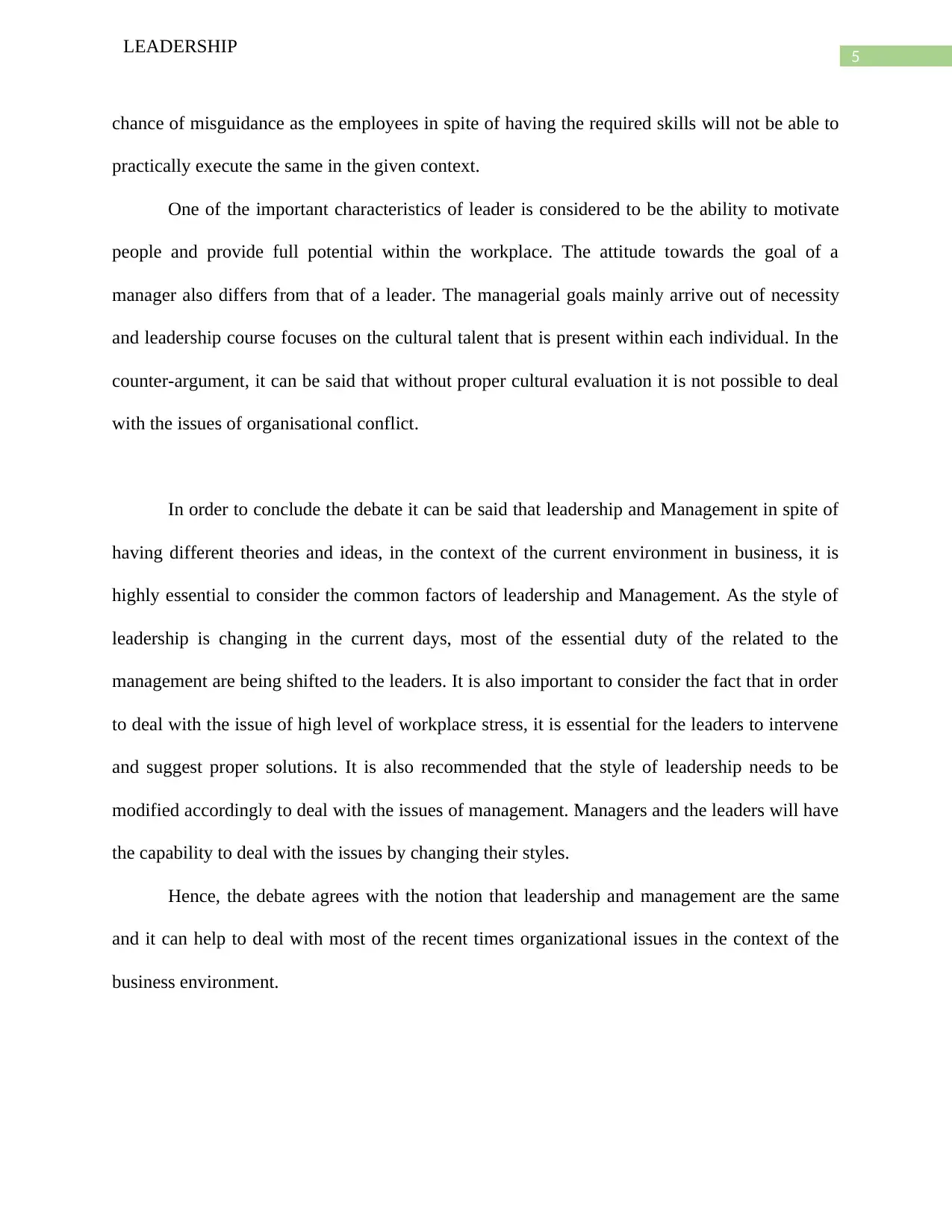
5
LEADERSHIP
chance of misguidance as the employees in spite of having the required skills will not be able to
practically execute the same in the given context.
One of the important characteristics of leader is considered to be the ability to motivate
people and provide full potential within the workplace. The attitude towards the goal of a
manager also differs from that of a leader. The managerial goals mainly arrive out of necessity
and leadership course focuses on the cultural talent that is present within each individual. In the
counter-argument, it can be said that without proper cultural evaluation it is not possible to deal
with the issues of organisational conflict.
In order to conclude the debate it can be said that leadership and Management in spite of
having different theories and ideas, in the context of the current environment in business, it is
highly essential to consider the common factors of leadership and Management. As the style of
leadership is changing in the current days, most of the essential duty of the related to the
management are being shifted to the leaders. It is also important to consider the fact that in order
to deal with the issue of high level of workplace stress, it is essential for the leaders to intervene
and suggest proper solutions. It is also recommended that the style of leadership needs to be
modified accordingly to deal with the issues of management. Managers and the leaders will have
the capability to deal with the issues by changing their styles.
Hence, the debate agrees with the notion that leadership and management are the same
and it can help to deal with most of the recent times organizational issues in the context of the
business environment.
LEADERSHIP
chance of misguidance as the employees in spite of having the required skills will not be able to
practically execute the same in the given context.
One of the important characteristics of leader is considered to be the ability to motivate
people and provide full potential within the workplace. The attitude towards the goal of a
manager also differs from that of a leader. The managerial goals mainly arrive out of necessity
and leadership course focuses on the cultural talent that is present within each individual. In the
counter-argument, it can be said that without proper cultural evaluation it is not possible to deal
with the issues of organisational conflict.
In order to conclude the debate it can be said that leadership and Management in spite of
having different theories and ideas, in the context of the current environment in business, it is
highly essential to consider the common factors of leadership and Management. As the style of
leadership is changing in the current days, most of the essential duty of the related to the
management are being shifted to the leaders. It is also important to consider the fact that in order
to deal with the issue of high level of workplace stress, it is essential for the leaders to intervene
and suggest proper solutions. It is also recommended that the style of leadership needs to be
modified accordingly to deal with the issues of management. Managers and the leaders will have
the capability to deal with the issues by changing their styles.
Hence, the debate agrees with the notion that leadership and management are the same
and it can help to deal with most of the recent times organizational issues in the context of the
business environment.
⊘ This is a preview!⊘
Do you want full access?
Subscribe today to unlock all pages.

Trusted by 1+ million students worldwide
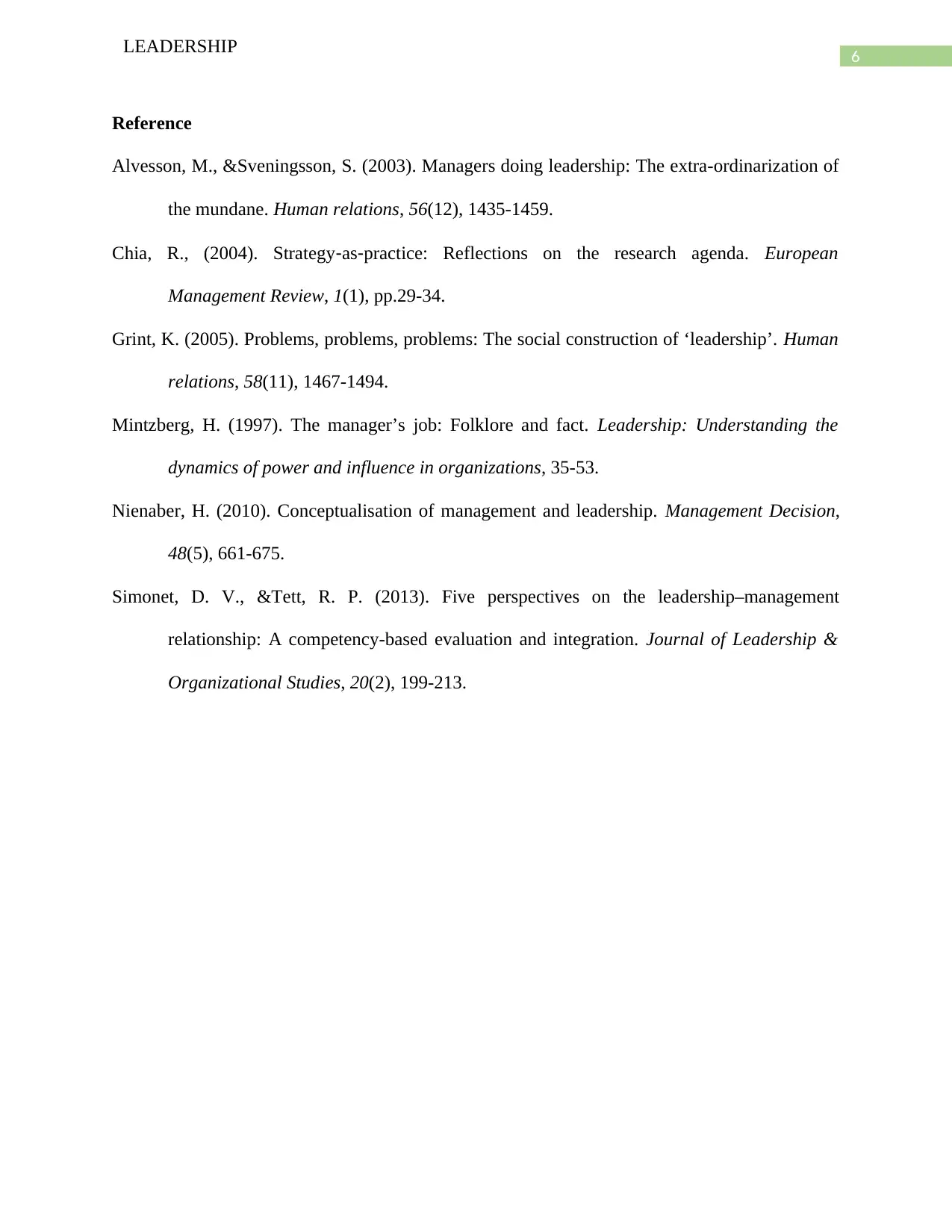
6
LEADERSHIP
Reference
Alvesson, M., &Sveningsson, S. (2003). Managers doing leadership: The extra-ordinarization of
the mundane. Human relations, 56(12), 1435-1459.
Chia, R., (2004). Strategy‐as‐practice: Reflections on the research agenda. European
Management Review, 1(1), pp.29-34.
Grint, K. (2005). Problems, problems, problems: The social construction of ‘leadership’. Human
relations, 58(11), 1467-1494.
Mintzberg, H. (1997). The manager’s job: Folklore and fact. Leadership: Understanding the
dynamics of power and influence in organizations, 35-53.
Nienaber, H. (2010). Conceptualisation of management and leadership. Management Decision,
48(5), 661-675.
Simonet, D. V., &Tett, R. P. (2013). Five perspectives on the leadership–management
relationship: A competency-based evaluation and integration. Journal of Leadership &
Organizational Studies, 20(2), 199-213.
LEADERSHIP
Reference
Alvesson, M., &Sveningsson, S. (2003). Managers doing leadership: The extra-ordinarization of
the mundane. Human relations, 56(12), 1435-1459.
Chia, R., (2004). Strategy‐as‐practice: Reflections on the research agenda. European
Management Review, 1(1), pp.29-34.
Grint, K. (2005). Problems, problems, problems: The social construction of ‘leadership’. Human
relations, 58(11), 1467-1494.
Mintzberg, H. (1997). The manager’s job: Folklore and fact. Leadership: Understanding the
dynamics of power and influence in organizations, 35-53.
Nienaber, H. (2010). Conceptualisation of management and leadership. Management Decision,
48(5), 661-675.
Simonet, D. V., &Tett, R. P. (2013). Five perspectives on the leadership–management
relationship: A competency-based evaluation and integration. Journal of Leadership &
Organizational Studies, 20(2), 199-213.
1 out of 7
Related Documents
Your All-in-One AI-Powered Toolkit for Academic Success.
+13062052269
info@desklib.com
Available 24*7 on WhatsApp / Email
![[object Object]](/_next/static/media/star-bottom.7253800d.svg)
Unlock your academic potential
Copyright © 2020–2025 A2Z Services. All Rights Reserved. Developed and managed by ZUCOL.




